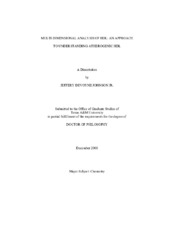| dc.contributor.advisor | Macfarlane, Ronald D. | |
| dc.creator | Johnson, Jr., Jeffery Devoyne | |
| dc.date.accessioned | 2010-01-15T00:12:29Z | |
| dc.date.accessioned | 2010-01-16T01:19:43Z | |
| dc.date.available | 2010-01-15T00:12:29Z | |
| dc.date.available | 2010-01-16T01:19:43Z | |
| dc.date.created | 2008-12 | |
| dc.date.issued | 2009-05-15 | |
| dc.identifier.uri | https://hdl.handle.net/1969.1/ETD-TAMU-3122 | |
| dc.description.abstract | Density gradient ultracentrifugation (DGU) is a powerful method for analyzing lipoprotein particles in great detail. It yields considerable amounts of information regarding the density distribution of these particles when coupled with fluorometric analysis and is an invaluable tool in determining their relative abundance. This union allows relationships between subclasses of lipoproteins to be established that gives researchers a more focused path to aid them in developing methods to predict the early onset of coronary artery disease (CAD). The research presented here focuses on the pairing of DGU with post-separatory techniques including matrix-assisted laser desorption mass spectrometry (MALDI-MS), liquid chromatography mass spectrometry (LC-MS), capillary electrophoresis (CE), isoelectric focusing (IEF) and apoptosis studies involving cell cultures.
It is becoming clearer that cholesterol concentrations themselves do not provide sufficient data to assess the quality of cardiovascular health. As a result, research is becoming more focused on identifying better markers that may be indicative of development of CAD in a patient. Of specific interest is group of particles known as high density lipoproteins (HDL). Classically, this molecule is considered the “good cholesterol”, but literature from the last decade suggests that there may be atherogenic variants to this group. By utilizing DGU as a preparatory method for secondary analyses, new dimensions can be added to the density distribution analysis to allow a better determination of markers of cardiovascular health. The aim of this work is to utilize the principles involved with these various techniques to develop a comprehensive set of methods to aid in the detection of potential risk markers.
In this study, the properties of metal ion complexes of EDTA as solute systems for analysis of lipoproteins by DGU are analyzed. We show that by varying the complexing ion and counter-ion of these metal-ion complexes, we gain the ability to control the separation of lipoprotein subclasses for subsequent analyses. Qualitative and quantitative data is presented that describes the analysis of different density regions of HDL for apolipoprotein content. Trends between control and atherogenic samples are also described and a clinical link between the biological activity of these regions and the chemical analysis is discussed. | en |
| dc.format.medium | electronic | en |
| dc.format.mimetype | application/pdf | |
| dc.language.iso | en_US | |
| dc.subject | Atherogenic | en |
| dc.subject | HDL | en |
| dc.subject | Apolipoprotein | en |
| dc.subject | Lipoprotein | en |
| dc.subject | Ultracentrifugation | en |
| dc.subject | EDTA | en |
| dc.subject | Electrophoresis | en |
| dc.subject | Spectrometry | en |
| dc.subject | MALDI | en |
| dc.subject | ESI | en |
| dc.title | Multi-dimensional analysis of hdl: an approach to understanding atherogenic hdl | en |
| dc.type | Book | en |
| dc.type | Thesis | en |
| thesis.degree.department | Chemistry | en |
| thesis.degree.discipline | Chemistry | en |
| thesis.degree.grantor | Texas A&M University | en |
| thesis.degree.name | Doctor of Philosophy | en |
| thesis.degree.level | Doctoral | en |
| dc.contributor.committeeMember | Russell, David H. | |
| dc.contributor.committeeMember | Smith, Stephen B. | |
| dc.contributor.committeeMember | Vigh, Gyula | |
| dc.type.genre | Electronic Dissertation | en |
| dc.type.material | text | en |
| dc.format.digitalOrigin | born digital | en |


